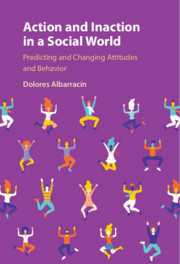Book contents
- Action and Inaction in a Social World
- Action and Inaction in a Social World
- Copyright page
- Dedication
- Contents
- Figures
- Tables
- Preface
- Acknowledgments
- Part I Introduction
- Part II Beliefs, Attitudes, and Behaviors
- Part III Influences of the Past and the Situation
- Part IV The Impact of Persuasive Communications and Behavioral Interventions
- Chapter 7 The Processing of Persuasive Communications and Behavioral Interventions
- Chapter 8 Persuasive Communications and Behavioral Interventions in the Context of Prior Attitudes and Behaviors
- Chapter 9 Actionability, Sources of Actionability, and Behavioral Impact of Persuasive Communications and Behavioral Interventions
- Part V Conclusion
- References
- Index
Chapter 8 - Persuasive Communications and Behavioral Interventions in the Context of Prior Attitudes and Behaviors
from Part IV - The Impact of Persuasive Communications and Behavioral Interventions
Published online by Cambridge University Press: 21 January 2021
- Action and Inaction in a Social World
- Action and Inaction in a Social World
- Copyright page
- Dedication
- Contents
- Figures
- Tables
- Preface
- Acknowledgments
- Part I Introduction
- Part II Beliefs, Attitudes, and Behaviors
- Part III Influences of the Past and the Situation
- Part IV The Impact of Persuasive Communications and Behavioral Interventions
- Chapter 7 The Processing of Persuasive Communications and Behavioral Interventions
- Chapter 8 Persuasive Communications and Behavioral Interventions in the Context of Prior Attitudes and Behaviors
- Chapter 9 Actionability, Sources of Actionability, and Behavioral Impact of Persuasive Communications and Behavioral Interventions
- Part V Conclusion
- References
- Index
Summary
Chapter 8 describes how prior attitudes shape the processing of persuasive messages and behavioral interventions in fundamental ways. First, people select messages and interventions in ways that minimize their likely impact. They seek pro-violence messages when they already espouse pro-violence beliefs and healthy eating messages when they already follow healthy diets. These decisions, of course, decrease the probability of changing attitudes and behaviors that have negative social and health effects, which has led to my research on finding methods to decrease selective exposure biases. For example, because selective exposure is often tied to a low sense of one’s ability to self-defend if one’s attitudes or behaviors come under attack, reassuring an audience that they will only change if they want to is often sufficient to increase exposure to messages and enrollment in behavioral interventions. In addition, understanding attitude and behavior change requires understanding activation of prior attitudes and other information contained in the message. For example, easy-to-access prior attitudes generally decrease change in response to new information but may also increase change when they facilitate comparison with new information. Furthermore, when people who are called to report an attitude retrieve the initial basis for their attitude, the structure of that information in memory drives the degree of attitude change in that situation. Different sleeper effects illustrate such effects of the initial representations of the information contained in a persuasive message.
Keywords
Information
- Type
- Chapter
- Information
- Action and Inaction in a Social WorldPredicting and Changing Attitudes and Behavior, pp. 221 - 272Publisher: Cambridge University PressPrint publication year: 2021
